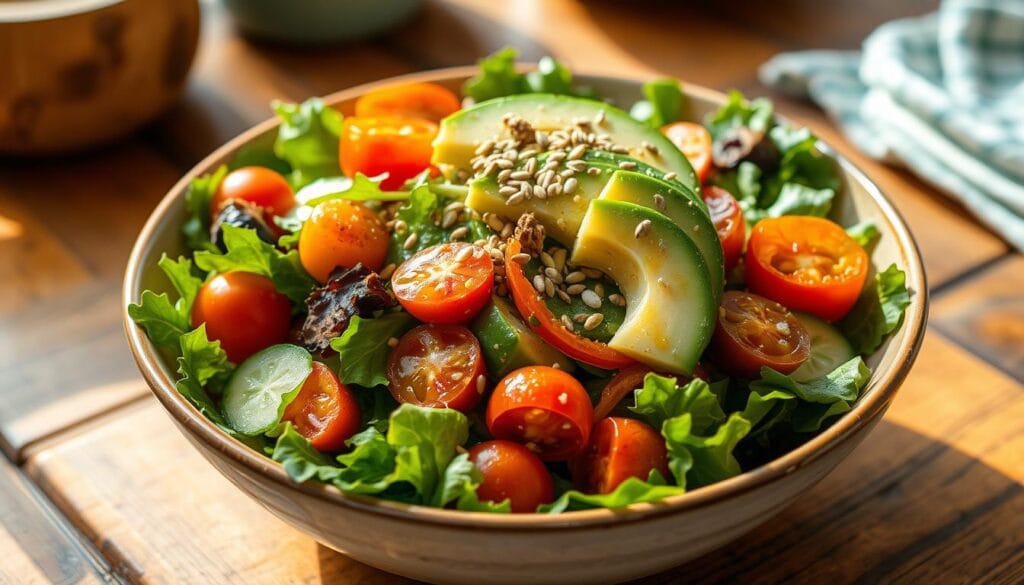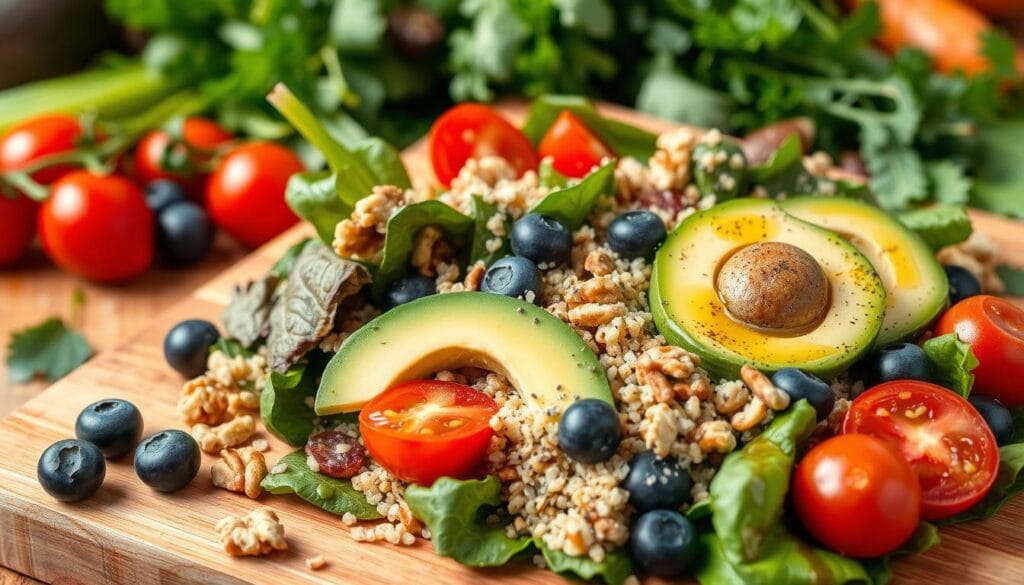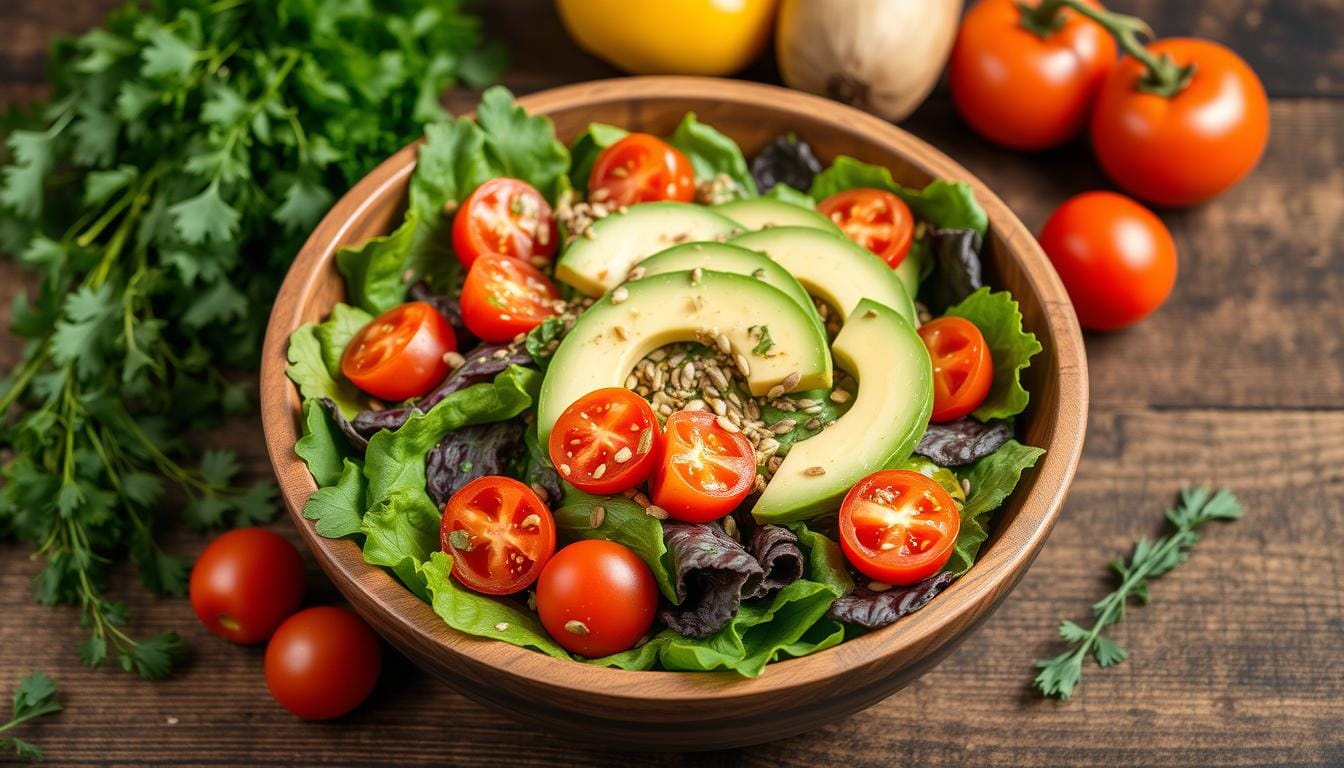As the sun peeked through my kitchen window, I craved a refreshing meal, and a healthy salad recipe was the perfect choice for a nutrient-dense start to the day. Today, I’m excited to share easy, delicious salads that will fuel you while supporting your health goals.
These salads are not only tasty but also packed with nutrients. Some have as few as 135 calories, while others offer up to 13 grams of fiber. They feature fresh ingredients like mixed greens, spinach, and fruits like apples and strawberries.
Looking for more plant-based meals or a guilt-free option? These salad recipes are perfect. From lentil and feta to tofu-topped watercress, there’s something for everyone. For a heartier meal, try the roast chicken and quinoa salad or the tuna poke bowl.
Introduction to Health Salad Recipes
Healthy salad recipes are great for nourishing your body and helping with weight loss. They are full of fresh veggies, fruits, lean proteins, and healthy fats. This makes them a balanced, low-calorie meal choice.
Benefits of Healthy Salads
Salads are rich in vitamins, minerals, and fiber. They boost your energy, improve digestion, and support overall health. You can also customize them to fit your taste and dietary needs.
Why Salads Support Weight Loss
Salads are perfect for losing weight. They are high in fiber, which keeps you full and satisfied. Plus, they are packed with nutrients that give you energy without adding too many calories. Adding salads to your meals can really help with weight loss.
Incorporating Salads into Your Diet
It’s easy to add salads to your daily meals. You can have them as a main dish, a side, or a quick snack. Making salads a regular part of your diet boosts your nutrient intake and supports your health.
Key Ingredients for a Nutritious Salad
Making a healthy salad begins with picking the right ingredients. Choose crisp veggies, energizing proteins, and healthy fats. Each part is key to a superfood salad.
Fresh Vegetables to Include
Fill your salad with a variety of fresh veggies. Kale, spinach, tomatoes, cucumbers, bell peppers, and carrots are great choices. Eating raw veggies can even boost your mood and mental health.
Protein Sources for Energy
Add a lean protein to your salad for energy and fullness. Grilled chicken, tofu, edamame, and quinoa are good options. For instance, 3 ounces of baked chicken breast has 22 grams of protein and 163 calories.
Healthy Fats to Add
Drizzle your salad with healthy fats from avocados, nuts, seeds, and olive oil. These fats boost flavor and help absorb nutrients. Eating a handful of nuts and seeds daily can lower heart disease risk.
For an extra boost, add superfoods like blueberries, dried cherries, and walnuts. They add antioxidants, fiber, and vital vitamins and minerals to your salad.
With a mix of fresh veggies, proteins, and healthy fats, your salad will be both nourishing and delicious.
How to Build Your Perfect Salad
Building a great salad is like creating a work of art. It’s all about layering, flavors, and the perfect dressing. Start with fresh greens, then add colorful veggies, proteins, and healthy fats. This way, you get a meal that’s both beautiful and healthy.
Layering Techniques
Start with your favorite greens as the base. Choose from spinach, kale, or mixed lettuces. Then, add crunchy veggies like carrots, cucumbers, or bell peppers. Include proteins like grilled chicken, chickpeas, or feta cheese for extra nutrition.
Finish with fresh herbs, nuts, and seeds. They add texture and flavor to your salad.
Balancing Flavors and Textures
A good salad has a mix of flavors and textures. Use sweet, savory, and tangy ingredients for a balanced taste. For example, mix juicy tomatoes with creamy avocado, crunchy almonds, and a citrus dressing.
The goal is to enjoy every bite. Find the right mix of crisp, creamy, and chewy elements.
Dressing Choices for Health
The dressing is crucial for your salad. Choose homemade vinaigrettes or yogurt-based dressings. They should be low in calories and rich in healthy fats like olive or avocado oil.
Try different herbs, spices, and citrus juices to add flavor. But remember, a little dressing is enough. Let the fresh ingredients be the stars.
Mastering layering, flavors, and dressing choices lets you create a health salad recipe. Your salad will look great and be full of fresh ingredients and salad dressing. Be creative and experiment, and you’ll enjoy a nutritious and delicious meal.
Easy Salad Recipes to Get You Started
Adding health salad recipes to your diet can change your wellness game. Whether you want to lose weight, feel more energetic, or just enjoy a tasty vegetarian meal, these salads are a great start. Let’s dive into some delicious options made with fresh ingredients.
Colorful Veggie Salad
This salad is a feast for the eyes and taste buds. Begin with mixed greens, then add diced bell peppers, cherry tomatoes, cucumber, and shredded carrots. Top it off with a light lemon vinaigrette for a refreshing meal.
Quinoa and Chickpea Salad
This salad is loaded with plant-based protein and fiber. It combines quinoa, chickpeas, feta cheese, olives, and fresh herbs. Mix it all with a zesty lemon-garlic dressing for a nutritious and tasty dish.
Spinach and Strawberry Salad
Make your greens sweet and tangy with this Spinach and Strawberry Salad. Start with fresh spinach, then add sliced strawberries, toasted almonds, and crumbled feta. Finish with a balsamic vinaigrette for a healthy yet indulgent salad.
These health salad recipes are ideal for beginners. They’re full of vegetarian meals and fresh ingredients. With their vibrant colors, satisfying textures, and nutrient-rich ingredients, they’re sure to become family favorites.

Tips for Preparing Your Salad Ahead of Time
Meal prepping your salad ingredients can change your healthy eating game. By washing, chopping, and storing your veggies and salad parts early, you save time and ensure you have a healthy salad recipe ready to go.
Meal Prepping Your Ingredients
Take a few minutes on the weekend to chop your favorite salad ingredients. This includes lettuce, cucumbers, carrots, and tomatoes. Store each in airtight containers in the fridge for easy assembly later. This step can save you up to 30 minutes each day.
Storing Salads Properly
When storing pre-made salads, keep the dressing separate until you’re ready to serve. This prevents your greens from getting soggy. Use mason jars or airtight containers to layer your ingredients. Place drier items like nuts and seeds on top to keep the greens fresh.
Quick Dressing Solutions
Make your salad dressings ahead of time for quicker salad assembly. Store them in small jars or containers in the fridge. Grab and go when it’s time to enjoy your salad. Some easy homemade dressing ideas include:
- Balsamic vinaigrette
- Lemon-herb dressing
- Creamy avocado ranch
By preparing your salad components on the weekend, you can enjoy healthy, delicious salads all week long.
Common Mistakes to Avoid When Making Salads
Salads are great for your diet, but watch out for common mistakes. By following a healthy salad recipe and avoiding these errors, you’ll make your salad tasty, healthy, and aligned with your healthy eating goals.
Overdressing Your Salad
It’s easy to add too much salad dressing. This adds extra calories and fat. Use only a tablespoon or two of dressing per serving. Let the fresh health salad recipe ingredients shine, not the dressing.
Using Low-Quality Ingredients
Choose the best fresh ingredients for your salad. Pick crisp, colorful veggies and fruits in season. This ensures your salad tastes great and is full of nutrients.
Skipping Protein
Protein keeps you full and satisfied. Add lean sources like grilled chicken, hard-boiled eggs, or chickpeas. Without protein, you might feel hungry soon after eating.
Avoid these mistakes to make delicious, healthy salads. With the right health salad recipe and quality ingredients, salads can be a great part of your diet.
Seasonal Salad Ideas for Freshness
Using seasonal ingredients is crucial for making tasty and healthy salads. A healthy salad recipe with fresh, in-season produce adds flavor and nutrients to your dishes all year. Here are some seasonal salad ideas to make your taste buds happy.
Spring Salads with Asparagus
Spring brings fresh flavors, especially with asparagus. This veggie goes well with spring greens like peas, radishes, and tender lettuces. A light, tangy vinaigrette brings out the asparagus’s natural sweetness.
Summer Salads with Watermelon
Summer calls for refreshing salads, like those with watermelon. Mix the sweet melon with crisp greens, tangy feta, and herbs. This mix of flavors is sweet, salty, and herbaceous, making you feel energized.
Fall Salads with Roasted Squash
Fall is the time for earthy flavors, like roasted squash. Combine squash with hearty greens, nuts, and maple dressing. This health salad recipe celebrates the fall harvest.
Using seasonal fresh ingredients makes your salads vibrant and tasty all year. By choosing what’s freshest, you enjoy delicious superfood salads and support local farmers and the seasons.
Serving and Enjoying Your Salad
Creating a tasty and healthy salad recipe is all about how you serve and enjoy it. Whether you’re trying to lose weight or just want to eat healthier, knowing the right portion sizes is crucial. Pairing your salad with other dishes is also important.
Portion Sizes for Weight Loss
For a main dish, aim for 2-3 cups of salad. This size gives you lots of fiber, vitamins, and minerals. It helps you feel full and satisfied. Remember, losing weight means eating fewer calories, so choose diet food and low-calorie dish options wisely.
Pairing Salads with Other Meals
Salads pair well with many main dishes. Try them with lean proteins like grilled chicken, salmon, or tofu. Adding whole grains like quinoa or brown rice also boosts energy and fiber.
Making Salads Family-Friendly
Get your family involved in salads by offering different toppings. Kids love making their own salads. Set up a “build-your-own-salad” station with veggies, cheeses, nuts, and more.
Salads are great for any meal plan. Focus on the right portion sizes, pair them with other healthy foods, and make them fun for the family. This way, salads can become a regular and enjoyable part of your diet food and healthy eating routine.
Creative Salad Toppings to Enhance Flavor
Adding a few simple ingredients can make your healthy salad recipe taste amazing. Try crunchy nuts and seeds, flavorful herbs, and creamy cheeses. These toppings can turn your salad into a delicious meal.
Nuts and Seeds for Crunch
For a crunchy texture, add nuts and seeds to your salad. Walnuts, almonds, or pumpkin seeds are great choices. They add flavor and are packed with nutrients like protein and vitamins.
Herbs and Spices to Elevate Taste
Fresh herbs can make your salad taste better. Basil, cilantro, or mint add a fresh aroma. Spices like cumin or chili powder can also enhance the flavor. Experiment with different herbs and spices to find your favorite.
Cheese Options for Creaminess
Adding cheese can make your salad creamy and rich. Try feta, goat cheese, or parmesan. These cheeses complement the fresh veggies in your salad.
With these toppings, your salad becomes a satisfying and tasty meal. It’s good for your body and your taste buds.
| Topping Category | Examples |
|---|---|
| Nuts and Seeds | Walnuts, almonds, pumpkin seeds, pecans, sunflower seeds, chia seeds, hemp hearts |
| Herbs and Spices | Basil, cilantro, mint, cumin, chili powder, oregano, garlic powder, onion powder |
| Cheese | Feta, goat cheese, parmesan, mozzarella, gorgonzola, gouda |

“Elevating your salad with a variety of crunchy, flavorful, and creamy toppings can transform it into a truly satisfying and nourishing meal.”
Conclusion: Making Salads a Habit
Adding a healthy salad recipe to your diet can boost your health and help with weight management. These salads offer a good mix of nutrients, better digestion, and support weight loss. It’s important to enjoy your salads and eat other healthy foods.
The Long-term Benefits of Salads
Eating a healthy salad regularly can bring many benefits. Salads make up about 11% of what adults eat, which is great for a balanced diet. They are low in calories and high in fiber, helping you feel full and aiding in weight loss.
The colorful mix of greens, veggies, and fruits in salads also boosts your health and immune system.
Finding Balance in Your Diet
While healthy eating with salads is key, don’t forget to balance your diet. Make sure salads are just part of your meal plan. Include whole grains, lean proteins, and healthy fats too. This balanced diet ensures you get all the nutrients you need while enjoying salads.
Encouragement to Experiment with Ingredients
To keep salads exciting, try new ingredients and flavors. Experimenting with different veggies, proteins, and dressings keeps things interesting. It’s a chance to be creative and find salad recipes you love.
By making nutritious salads a regular part of your life, you’ll see long-term health and weight benefits. Stay inspired, be adventurous with your ingredients, and enjoy the journey to a healthier lifestyle.
Additional Resources for Healthier Eating
Starting your journey to healthier eating? There are many resources to help and inspire you, including cookbooks, blogs, and meal planning apps. These tools will help you find the perfect healthy salad recipe and meet your nutritional needs.
Recommended Cookbooks and Blogs
Check out cookbooks like “The Salad Bowl” by Jane Smith and “Salad Days” by Sarah Johnson. They offer tasty and healthy salad recipes. Also, visit blogs like “Greens and Grains” and “Salad Lover’s Corner” for more salad ideas and tips.
Apps to Help with Meal Planning
Meal planning apps can make healthy eating easier. Apps like “Meal Prep Pro” and “Salad Scheduler” help plan meals and make grocery lists. They also give nutritional info for your ingredients. Using these apps can save you time, reduce waste, and keep your body nourished with salads.
Nutrition Guidelines for Optimal Health
To get the most health benefits from your salads, learn about nutrition guidelines. The USDA and CDC have great info on balanced diets and nutrient needs. Knowing these guidelines helps you create salads that support your health goals.
FAQ
What are the benefits of incorporating health salad recipes into my diet?
Health salad recipes help with weight loss and boost energy. They are full of vitamins, minerals, and fiber. These ingredients support your overall health and wellness.
What are some key ingredients to include in a nutritious salad?
A good salad has fresh veggies like kale and tomatoes. Add protein from chicken or tofu for energy. Avocados and nuts add healthy fats for flavor and nutrition.
How can I build the perfect salad?
Start with leafy greens and mix sweet, savory, crunchy, and creamy elements. Use homemade vinaigrettes for dressing. Add herbs and spices for flavor without extra calories.
What are some easy salad recipes to try?
Try a Colorful Veggie Salad or a Quinoa and Chickpea Salad. Also, make a Spinach and Strawberry Salad with feta and balsamic. These are easy, healthy, and great for beginners.
How can I prepare salad ingredients in advance?
Wash and chop veggies ahead of time. Store them in airtight containers. Keep dressings in small jars. Use simple ingredients for quick dressings. This saves time and keeps your salads healthy.



